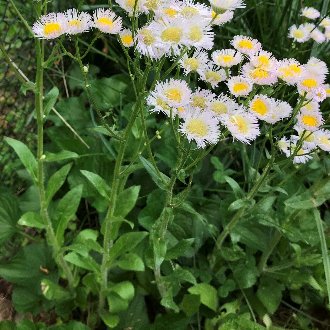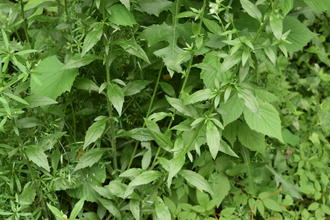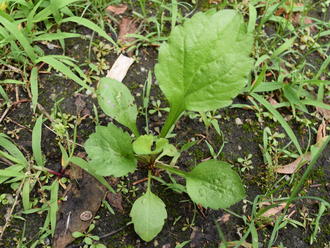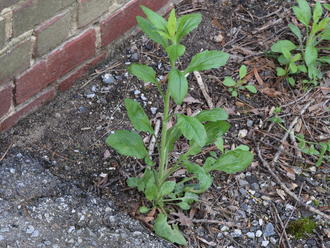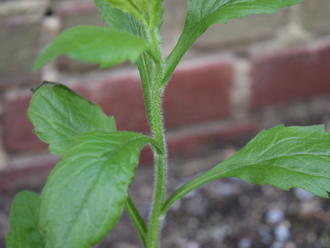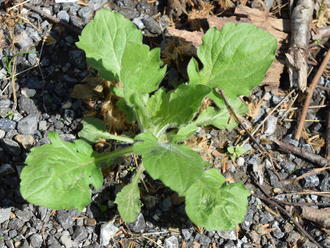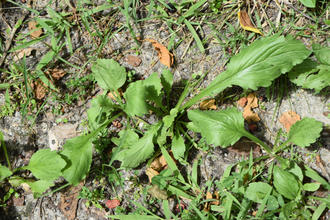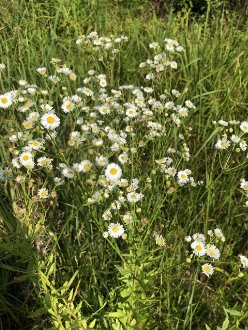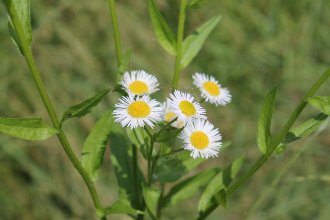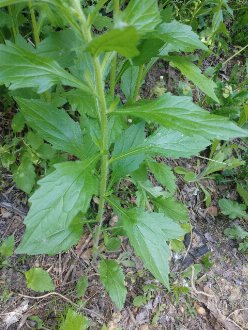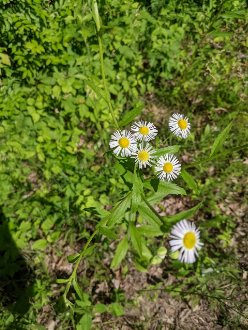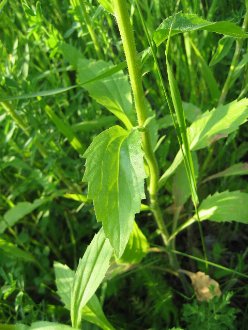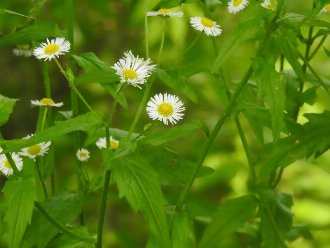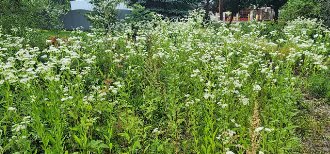Annual Fleabane (Erigeron annuus (L.) Pers.)
Also known as eastern daisy fleabane.
↑Summary
A common weedy annual or biennial native to Eastern North America, and introduced along the West Coast and nearby interior regions.
↑Range - Expand
| Legend | Color |
| Native | |
| Introduced | |
| Native or Not Present | |
| Introduced or Not Present | |
| Native or Introduced |
This tentative map is based on our own research. It may have limited data on Canada and/or Mexico, and there is some subjectivity in our assignment of plants as introduced vs. expanded. Read more in this blog post.
Although this plant occurs somewhere in each of these regions, it may only occur in a small part of some or all of them.
This species is native to the eastern US and Canada and introduced in the western US; it may or may not be native to BC, Canada. There are likely unreported populations in the interior west. We have not yet completed the portion of this species' range map in Canada.
↑Description & Identification
E. annuus is highly variable in characteristics, including size and growth habit and bloom time. This morphological plasticity is largely driven by environment; since this species only reproduces asexually, there is relatively little genetic diversity between individuals.
To distinguish from other Erigeron species, it often, but not always, has more leaves and larger leaves than other fleabane species. Its leaves do not clasp the stem at the base.
↑Similar Plants
↑Habitat
Annual fleabane is a generalist pioneer species. Its natural habitats include prairies and disturbed sites in open woodlands. Anthropogenic habitats include pastures, abandoned fields, roadsides and railroads, and waste areas. In the humid east, more common in anthropogenic habitats but occasionally found in wild habitats as well, where it is primarily a pioneer species. In the west of its range it is found in more stable grassland habitats as a longer-term resident, although it still favors locally-disturbed sites.
Prefers full to partial sun and moist to mesic conditions. Tolerates a wide variety of conditions, including soil with significant amounts of clay and/or gravel. It is usually limited to sites that have experienced recent disturbance. Because it prefers sites rich and moist enough to support forests in the east, and lusher vegetation that would outcompete it in the west, it is usually absent from later-successional stages of ecosystems in which it is found, and will eventually be eliminated from most sites in the absence of disturbance.
This species often occurs together with other Erigeron species. Relative to Philadelphia fleabane (Erigeron philadelphicus), this species ranges into drier habitats, whereas relative to prairie fleabane (Erigeron strigosus) and oakleaf fleabane (Erigeron quercifolius), this species prefers moister habitats and richer soil and is more tolerant of competition from other plants. Relative to Robin's plantain (Erigeron pulchellus) this species prefers sunnier, moister habitats with richer soils. Of these species it is most likely to occur together with E. philadelphicus.
↑Life Cycle
This species is an annual-to-biennial plant that is strictly asexual, reproducing only by apomixis or agamospermy, clonal reproduction through seeds.
Although its name suggests an annual lifecycle, this species is opportunistic and has a flexible life-cycle. Seeds can germinate at various times, although they most frequently germinate in late summer.
Plants establishing in spring and in favorable conditions typically grow as summer annuals, growing upright, flowering, producing seed, and dying. Plants that establish in conditions that slow their growth, including greater shade, less moisture, and less fertile soil, may overwinter and bloom in their second year. A majority of plants, germinating in late summer to early fall, grow as winter annuals and bloom in the following year. Overwintering plants maintain an evergreen basal rosette of leaves in mild winters, and are deciduous in colder winters.
Flowering time is wildly variable, ranging from May through November, although earlier times are more common. Typically, well-established overwintering plants make up the majority of plants, and most of these plants will bloom closer to May or June. Typically this species flowers after E. philadelphicus and E. pulchellus, and around the same time as E. strigosus. Drought stress or top-kill such as from herbivory or mowing, followed by a period of favorable conditions, can sometimes delay flowering. Some plants flower well into fall, with delayed flowering being even more common in urban areas where shelter and ambient heat from buildings can protect late-blooming plants from frost.
As this plant does not rely on cross-pollination to reproduce, it does not need to time blooms to coincide with other individuals of its species, nor is it affected by competition for pollinators so it also does not need to avoid its bloom period coinciding with related species. This may explain why this species has the most variable bloom period of most Erigeron species in its range.
↑Faunal Associations
Some mammals, including both domestic sheep and wild deer, browse the foliage. The seeds are eaten by the introduced house mouse (Mus musculus) and the native white-footed mouse (Peromyscus leucopus).
In spite of reproducing only asexually, the flowers produce nectar and pollen, and attract a large variety of small pollinators. Pollinators include sweat bees (Halictidae), masked bees (Hylaeus sp..), Sphecid wasps, Vespid wasps, hoverflies (Syrphidae), soldier flies (Stratiomyidae), green bottle flies (Lucilia sp.), Tachinid flies, flesh flies (Sarcophagidae), and some bugs and beetles.
There are also numerous insects that eat the other parts of this plant, including the foliage and roots. The leaf beetle Calligrapha praecelsis eats the leaves and the larvae of the gall midge Asteromyia modesta forms galls on this species. The generalist tarnished plant bug (Lygus lineolaris) and broken-backed bug (Taylorilygus apicalis) both eat this among many other plants. The red-spotted aster mirid (Polymerus basalis) alse eats this plant. At least three aphids feed on this plant: Uroleucon erigeronense, which specializes on fleabanes, Uroleucon gravicorne, and the gall-forming aphid Prociphilus erigeronensis.
The lynx flower moth (Schinia lynx) eats this and other Erigeron sp., as well as camphorweed (Heterotheca subaxillaris). The larvae of three generalist leafroller moths (Tortricidae family) eat this species: the omnivorous leafroller moth (Archips purpuranus), the blueberry leafroller (Sparganothis sulfureana), and Xenotemna pallorana.
↑Control
This species has been introduced in western North America and some people may want to remove it as it is not native there. It has become a highly invasive plant in parts of the world, including East Asia, although it has yet to exhibit this effect on the ecosystems in western North America.
This species has high seed production and can be difficult to remove from suitable sites if it is allowed to go to seed. It is easiest to learn how to identify plants before they flower, as seeds can be produced and dispersed quickly after flowering. Plants can then be uprooted.
Because its seeds are dispersed in the wind, this species will continue to reappear as long as there are nearby populations.
Large infestations can sometimes be controlled by a change in mowing regime. In areas where this species grows taller than the native vegetation, a few carefully-timed mows during the time period where this species is growing upright can eliminate it from a site, or at least greatly reduce seed production. However, care must be taken that such mowing is not more disruptive to native vegetation. In other cases, avoiding mowing an area at all may eliminate it if it leads to it being out-competed by taller, native vegetation. Often, mowing was the disturbance that allowed this species to take hold, so avoiding mowing areas at risk of colonization by this species can prevent it from establishing.
It is important to emphasize that this species is ecologically beneficial within its native range, and it is important to avoid control attempts in regions where it is native.
↑Uses
This species is occasionally used in wildlife plantings and gardens. It transplants readily during the basal rosette stage of growth. More often, it is not intentionally planted, but rather, left in place by ecologically-minded gardeners when it seeds into their garden.
In gardens it is valued for its attractive flowers and widespread adaptability. Its use can be limited by its tendency to spread aggressively in some garden settings.
It can also be used in ecological restoration plantings, where it often competes favorably against invasive plants. It is easy to seed in as well as transplant into a site. Seeding works best on sites where the soil has been disturbed and competing vegetation removed. Transplanting established rosettes can be done on sites where the disturbance happened slightly earlier, as these plants may establish faster and will be able to grow upwards and compete more readily with other vegetation.
Because this plant is common, it usually shows up on its own in suitable habitat. The best way to utilize it is to ensure anyone managing an area, including weeding, trimming, or otherwise removing plants, knows how to identify this plant and knows not to remove it.
↑Related Plants
Throughout most of its range, this species co-occurs with three other native Erigeron species: E. philadelphicus, E. strigosus, and E. pulchellus. It overlaps with a few other species around the margins of its range.
We have been unable to find research or data on which of these species are most closely-related.
↑Notes
We prefer the common name "annual fleabane" as it is both unambiguous and descriptive, in that this is the Erigeron species most likely to grow as an annual (excepting horseweed (Conyza canadensis), often placed in this genus but not referred to as "fleabane".) However this name may be slightly misleading in that this species also often grows as a biennial.
The other common names for this species are more ambiguous. "Daisy fleabane" also refers to prairie fleabane (Erigeron strigosus), perhaps reflecting the fact that that species has visually-similar flowers and the two species are hard to tell apart. Although the name "eastern daisy fleabane" is unambiguous, only referring to this species, we recommend avoiding it because it is potentially confusing and less descriptive.
↑Links & External Resources
• Erigeron annuus (Annual Fleabane) | Illinois Wildflowers (About This Site)
• Erigeron annuus (Annual Fleabane) | USDA PLANTS Database (About This Site)
• Erigeron annuus | Go Botany (About This Site)
• Erigeron annuus | Biota of North America Project (BONAP) (About This Site)
• Erigeron annuus | NatureServe Explorer (About This Site)
• Erigeron annuus | Flora of North America (About This Site)
• Erigeron annuus | Missouri Plants (About This Site)
• Annual Fleabane | Maryland Biodiversity Project (About This Site)
• Erigeron annuus (Annual Fleabane) | Minnesota Wildflowers (About This Site)
• Erigeron annuus (L.) Pers. (Annual Fleabane) | Digital Atlas of the Virginia Flora (About This Site)





